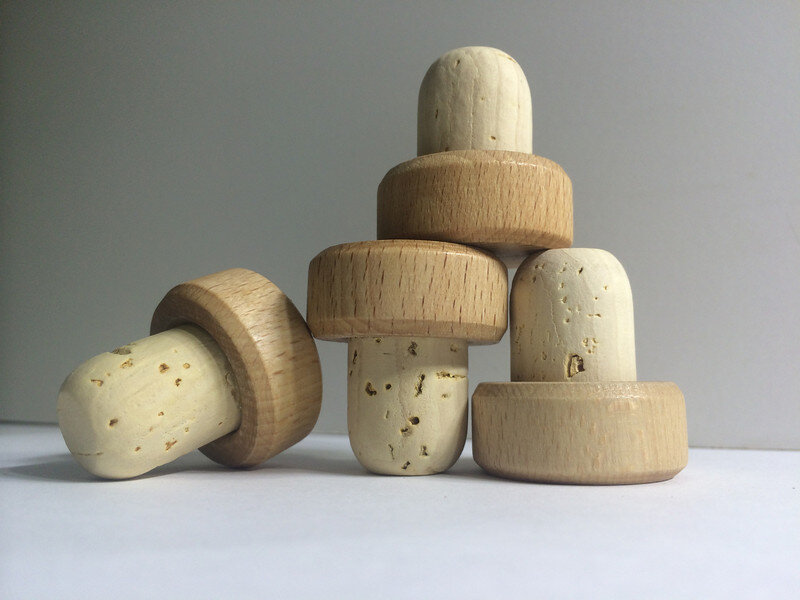Stoppers & Closures
There are endless types and sizes of closures and stoppers available. Although there are standard sizes to fit common bottles such as those used in the wine and liquor industries or for a variety of construction and building uses, Jelinek Cork Group also specializes in custom sizes to fit any types of bottles and jars, or any openings requiring tight seals.
Both natural cork and synthetic cork closures can also be combined with wood, metals, granite, glass or plastic to create beautiful and decorative stoppers. These are often used by distilleries as closure for their high brandy. Similar closures and stoppers are also used on certain wines as well as on many different cosmetic, spice, and specialty bottles and containers.
Jelinek works closely with customers to ensure that the cork quality, size, and finish is correct for any given project or requirement.
Learn more about some of the Stoppers and Closures, Jelinek Cork Group is pleased to supply. If you do not find what you are looking for, please contact us.
Quick History
The fascinating Minoan civilization flourished on the Mediterranean island of Crete from approximately 3000 B.C. to 1200 B.C. During the 20 th century, numerous archaeological excavations of this ancient civilization unearthed jars, vases, and other types of pottery containers. Many of the pottery urns found were still sealed with stoppers carved from cork. These are on display today in several museums on Crete and elsewhere.
The Egyptians of thousands of years ago are also known to have used natural corks for sealing their wine jugs and the Romans learned that cork as a bottle stopper would preserve wine and olive oils longer and better then the wooden stoppers used during those times. However, it was not until the 17 th century A.D. that cork stoppers began to be truly used as modern day wine closures.
The use of modern day cork stoppers can be attributed to a French monk by the name of Dom Perignon. Today the world renowned French champagne still bears his name. In the 1600’s this clever monk began using natural cork stoppers to seal his sparkling wines and in so doing revolutionized the sealing of bottles and containers. Up to that time sparkling wine had traditionally been “sealed” by wooden plugs wrapped in hemp soaked with olive oil. Dom Perignon triggered the use of cork, making it quickly essential for wine bottling. The only remaining problem was the extraction of the corks but with the invention of the corkscrew in the early 1700’s cork stoppers were fully accepted as the only viable wine closure. This new and modern phenomenon quickly caught on and cork was soon being used as a sealer in bottles, flasks, and containers not only of wines but also beers, spices, oils, liquors, and other beverages and foods.
The world’s first commercial cork stopper factory opened in Spain around 1750. Production boomed requiring more and more cork factories, not only in Spain but also in Portugal, to punch out stoppers from the bark of the cork oak tree as quickly as possible. Demand was high, spurred on by advanced glass technology which allowed for mass produced glass bottles. These glass bottles when sealed with cork stoppers allowed completed products to be easily distributed and transported out of local regions to larger markets around the world. Today there are some 15 billion wine corks produced each year plus several billion other types of cork stoppers to serve other industry demands.
General Use
There are endless types and sizes of closures and stoppers available. Although there are standard sizes to fit common bottles such as those used in the wine and liquor industries or for a variety of construction and building uses, Jelinek also specializes in custom sizes to fit any types of bottles and jars, or any openings requiring tight seals. Both natural cork and synthetic cork closures can also be combined with wood, metals, granite, glass or plastic to create beautiful and decorative stoppers. These are often used by distilleries as closures for their high end quality products such as bourbon, whiskey and scotch, tequila, cognac, and brandy. Similar closures and stoppers are also used on certain wines as well as on many different cosmetic, spice, and specialty bottles and containers. Jelinek works closely with customers to ensure that the cork quality, size, and finish is correct for any given project or requirement. Contact us with your specific requirements.
Jelinek Quality Control and Assurance
It is recognized that the quality, appearance, and functionality of cork stoppers and closures is critical to the overall quality of the product it is meant to seal and the packaging it is designed to compliment. Jelinek follows strict product assurances and controls to meet or surpass specifications and technical requirements on all stoppers and closures. Stringent laboratory analysis through ongoing quality control testing before, during and after production ensure shipments conform to specifications.





